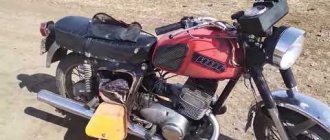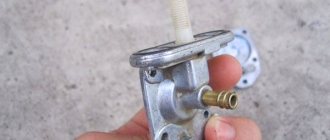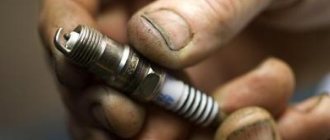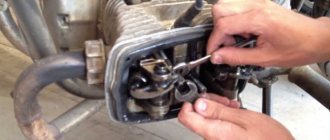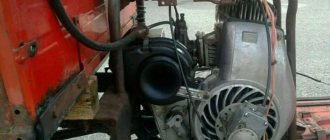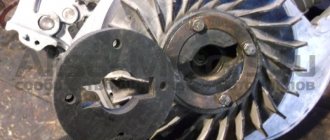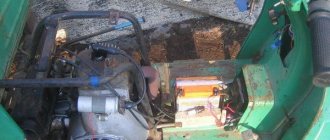It would seem that this is happiness: buy a new piston at the nearest dealership, quickly disassemble the engine, peel off the old scabs from the parts, put everything back together and enjoy unsurpassed drive. But no guys, it’s not that simple. If everything were so simple and easy, the masters would have already become rich long ago and would look at you with contempt, and not with lust as they do now.
The first sign that something is wrong with the engine is poor starting and poor traction. All your attempts to adjust the carburetor or ignition for the hundred-fifty-thousandth time will lead to nothing. Because poor starting and weak traction are 100% a symptom of weak compression in the crank chamber and in the combustion chamber. Today's case confirms this.
Cleaning and adjusting the carburetor
If you don't know why the scooter stalls when you give it gas, first check and adjust the carburetor. If it was often removed and adjusted, it may be that somewhere it began to leak air. If such a problem occurs, you can use a sealant or buy gaskets for the carburetor.
Let’s say the scooter stalls, you don’t know what to do. Then the first thing we do is clean the carburetor. Mostly the jets and auxiliary systems become clogged with dirt, so after cleaning the carburetor and adjusting all the jets, you can try to start the scooter again and give it gas. If the problem is not solved, move on to the main action - adjusting the needle to adjust the quality of the mixture. The needle in the carburetor performs the main task - adjusting the amount of fuel that is then supplied to the combustion chamber. Basically, you can adjust the quality of the mixture using a special jet on the carburetor, but if working with it does not produce results, you will have to manipulate the needle.
The needle is in close contact with the throttle handle, so when the handle is opened, the needle rises up and allows fuel to be supplied. That is, the higher the needle is raised, the more gasoline flows in and the power increases. Power guarantees better speed and traction. If you disassembled the carburetor, taking out the needle you will see 5 grooves on it, one of which has a retaining ring installed. Typically, such a ring is located in the center, that is, on the 3rd groove. If you lift the locking ring up, the needle will drop lower. This allows a leaner mixture to be supplied to the evaporation system, in which more air is supplied than gasoline. When installing the ring on the 4th and 5th grooves, the mixture becomes richer, where more gasoline is supplied than air.
Carburetor design K 65
To adjust the carburetor of the K 65 model, you first need to become familiar with its structure. The supply and maintenance of fuel level occurs according to the following scheme. Through the fitting, fuel is supplied to the valve with an elastic locking washer. This block rests on a tongue that communicates with the floats. They are made of plastic and interconnected. The floats rotate freely along their axis.
If there is more fuel, its excess is drained through the drainage hole from the float chamber. Model K 65 (carburetor) heats up during operation. At the same time, so that the pressure in the chamber does not increase, it is connected to an unbalancing channel.
- Do-it-yourself carburetor adjustment for VAZ 2107
The next system that needs to be considered in the K 65 carburetor circuit is the dosage device.
Why does the scooter stall at idle?
A scooter, like any piece of equipment, can break down over time. Therefore, it needs to be checked and maintained from time to time. If the scooter is not serviced in a timely manner, it will therefore not serve you for a long time and faithfully. Even Chinese devices serve faithfully in capable hands. Today we will talk on the topic: “Why does the scooter stall at idle.”
Scooter stalls at idle
It happens that the scooter works well and picks up speed without problems. But if you release the throttle, the scooter will go into idle mode and stall. Most often this happens when it has not yet warmed up and without accelerating it stalls. But it happens that this happens after warming up or driving for a long time. What to do in such cases? Why does my scooter stall at idle? If it has not yet been run-in, then most likely you should just finish it and everything will work out. But if this is not related to the running-in, then we are looking for the reason.
Stalls at idle: reasons
The reason that the scooter stalls at idle may be a lean mixture (or a breakdown in the fuel system) or bad gasoline. Before starting repairs, check the quality of gasoline. If this starts after refueling, then you need to drain the gasoline and refuel at a proven gas station (you can rinse the tank with acetone). If this does not help, then you need to check the enricher itself and the mixture enrichment channels. If there are no problems there and the scooter stalls at idle, then we move on. We check the entire fuel system: - Carburetor. We remove and disassemble it. We completely wash every part and every channel. We put it back together in the same order as we took it apart. — Air filter. The paper one needs to be blown out with a compressor. If the condition is completely bad, then you need to replace the filter. We wash it with gasoline and dry it a little. Then soak it in oil. Squeeze out any excess glass in your hand. — Vacuum valve. Remove both hoses from the carburetor. We take the thin one into our mouth and suck it into ourselves. This is done to create a vacuum. At this time, gasoline should actively flow out from the other hose. If gasoline flows out sluggishly, you need to remove the vacuum seal and rinse, blow out, and clean it. After this, warm up the scooter well and adjust the idle speed.
If the scooter continues to stall at idle, then the possible reasons are: - The electric enrichment unit is jammed or incorrectly installed - The jets or the enrichment channel are poorly washed - The air filter is not sufficiently saturated or not saturated at all. — The carburetor is in poor condition. To check, you can tighten the quality screw completely and unscrew it one turn. This will be a very rough setting that will need to be reconfigured, but now you can check it will fix the scooter stalling at idle.
Idle system
Another important system that must be taken into account when adjusting the K 65 carburetor is the idle speed device.
The presented system consists of a fuel pipe, an air channel, an idle hole, mixture quality and quantity screws, and a transition hole.
When the engine operates at low speeds, an emulsion is formed. This occurs by raising the fuel through the tube under the influence of vacuum in the mixing chamber. The fuel is combined with air, which enters through the channel. The K 65 carburetor assumes that the emulsion exits at low speeds only through the idle hole.
- Reasons for the high fuel consumption of the carburetor VAZ 2107
As the speed increases, the vacuum in the hole area increases. The same emulsion also begins to flow through it. So the fuel supply increases as the engine speed increases.
Typical reasons
Starting a scooter in cold weather may not always be possible due to various factors. First of all, you shouldn’t torture the equipment if it doesn’t start right away. Check the following:
- Battery condition. If its charge is less than 12 A, the starter will not work. The normal voltage should be 14.5, this can be checked using a voltmeter. Try kickstarting the scooter.
- No spark. If the scooter was working fine, but then stopped starting, you should check to see if there is a spark. To do this, you need to pull out the spark plug and check its condition. The problem could also be with the coil or switch.
- The equipment may not be satisfied with the quality of gasoline.
- The malfunction may be hidden in the power system. If the scooter has trouble starting when cold, try adjusting the carburetor.
Malfunctions in the power system
The power system may be to blame; If the piston group of the engine is working properly, then you should check whether gasoline enters the combustion chamber or not. This is easy to check: unscrew the spark plug and inspect it; if it is wet, it means gasoline is flowing. If it’s dry, we start checking with the gas tank: first, you need to find out if there is gasoline in there. If there is, check whether the tap is open. If everything is open, you need to remove the vacuum hose and clean it with air.
If everything is in order, move on to the carburetor float chamber. The bottom of the device is removed; it is usually held on by bolts. It contains a float. If the chamber is full, but gasoline does not flow to the cylinder, the nozzle is most likely clogged. You will need to pull out the needle, remove debris, dust, and all foreign particles. You can also check the scooter's petal valve: it is located below the carburetor. The petals may be damaged, causing the scooter to not start even if it is new. If the petals are not closed tightly enough, the valve must be replaced. In some cases, you can bend the petals with your fingers, but this measure will only help for a short time - only to start the scooter several times and ride it for parts.
In case of serious damage, you should check the piston, whether it gives the required compression ratio, the seals of the piston system, the CPG and the ignition system. But these reasons are more likely characteristic of old equipment that was not properly cared for.
No spark in spark plug
First of all, you should check the spark plugs if the moped does not want to start.
- The spark plug needs to be unscrewed. You can check it using a special device that is sold in car dealerships; it's inexpensive. You can inspect the candle visually. It should not be black or damaged.
- If the candle is wet, it needs to be dried. This should not be done with open fire.
- The candle may be stained with oil and carbon deposits may be visible on it. All this is cleaned with metal brushes, similar to toothbrushes.
- An easy way to check if there is a spark is by unscrewing the spark plug, putting the wire on it leading to the ignition coil and placing it on the cylinder. If you turn the starter, you will see a spark. If the spark plug is working but there is no spark, the problem is in the ignition coil.
Attention! The procedure must be carried out carefully, without touching the scooter frame or other metal objects with your bare hands, otherwise you will get an electric shock.
If there is a spark and its color is yellow, then you need to install a new spark plug; yours is no longer suitable for use. A normal spark is blue and flows continuously.
If the coil is new, as are the spark plugs, but there is no spark, it is still worth checking the following:
- Oxidation of electrical wire contacts. They will need to be cleaned; for example, the wires going to the battery often become oxidized.
- No spark on the wire. This means that somewhere there is a bare wire that touches an ungrounded metal part, because of this the spark does not appear, since the current does not reach the coil. Check the wiring.
- The switch may also fail. This is an inexpensive item that it doesn’t hurt to always have in reserve.
Symptoms
The engine starts with great difficulty, there is practically no traction. The owner swears and swears that everything was installed new (you know the symptom too).
In such cases, first of all, you need to check the spark, the ignition timing, the carburetor, the rubber gaskets under the carburetor (the gaskets often burst and thickly and begin to suck air through the cracks) and, just in case, the air filter. If nothing suspicious is found in these devices, measure the compression in the combustion chamber and if it is below 8 kg/cm, feel free to open the piston
In our case, the piston is new, so we will not measure the compression, but will immediately remove the head and see how things are going there. But things here are neither bad nor good: new parts are so disgusting that you need to think three hundred times before buying them.
The new head turned out to be crooked and a fair amount of compression was lost through it. The matter was further complicated by the fact that the cylinder liner was pressed flush with the cooling jacket. Over time, the sleeve warped a little, literally by a tenth of a millimeter, due to which the already crooked head began to rest on the shirt in one place and a decent gap formed between it and the sleeve.
The presence of oil under the head can indirectly indicate depressurization of the combustion chamber. You can see for yourself how much oil there is... How can you drive like this and still wonder why the engine won’t start? How can it start if all the compression has escaped through leaks?..
The white holes around the sleeve show how much the head fits onto the shirt and fits decently: in some places by 6 mm
Dark spots on the plane of the head indicate leaks. It was siphoning through them. The problem is actually not that serious: we grind the head and forget about the problem forever
Where the head holds well there is not even a hint of oil: everything is clean
Some smart guy made the sleeve flush with the shirt and also made the head so that it lay on both the sleeve and the shirt at the same time, who does that? It is clear that the sleeve will warp from heating and the head will no longer ensure a tight connection: in our case, the sleeve sagged a little on one side. On the original cylinders, the sleeve was recessed into the shirt and the head rested only on it, but in this obscenity everything was done like a pig
For a factory cylinder, the liner is recessed into the jacket and the head rests only on it
The spark plug is not working properly
The moped will not start if the spark plugs are faulty. To diagnose this, you need to check the spark plug and the area under it. The place under the candle should be completely dry. A wet spark plug means there is too much gasoline in the fuel mixture. If something is wrong, the area under the candle needs to be wiped dry.
Very often, starting the engine is prevented by carbon deposits on the spark plug, which prevents it from producing a spark. Using a spark plug, you need to unscrew the spark plug and check it. It's very simple. To check if the spark plug will work, you need to put a cap on it and touch its bottom to the frame of the bike.
Then you need to try to start the bike using the kickstarter. If there is no spark, it means that the contacts in the spark plug cap are not functioning. Then the contacts are “pressed”. And if a spark does not appear even after this, the spark plug needs to be changed.
Adjusting the fuel level
Adjusting the K 65 carburetor begins with setting the fuel level. To do this, turn the device over and remove the bottom of the float chamber. Next, replace the distance from the connector to the line that divides the float into two parts.
This distance is usually 13 mm with a possible deviation of 1.5 mm in both directions.
If the size on the carburetor does not fit into these frames, you should bend the float tongue in the desired direction.
It happens that the K 65 carburetor is configured correctly, but it begins to “overflow.” This means that the float has leaked.
Testing this theory is easy. You need to fill the bath with warm water and immerse the float in it for a minute or longer. If bubbles appear, the float is faulty.
Reasons for lack of spark
Often, owners may encounter cases of starting failure in the cold season, although the moped drove well in the autumn. Initially, you need to unscrew the spark plug and carefully inspect for spark, oiliness and color.
Carbon deposits on the electrode
There may be no spark, if the electrode is covered with carbon deposits, then they are cleaned with a metal brush. If there is even the slightest doubt about the serviceability of the spark plug, you should replace it immediately, thereby making your life easier in the future.
Acidification of contacts
If the external signs of the spark plug correspond to suitability, and there is also no spark, then you need to check whether there is a discharge. It is worth noting that you need to be extremely careful, as it can give you an electric shock. If there is no spark and the external signs of the spark plug are normal, then the scooter is checked electronically for acidification of the contacts.
Insufficient fuel
If there is a spark, but the moped still has difficulty starting from the starter in cold weather, you should pay attention to the fuel tank. If it is empty, then it is filled. It is worth noting why old gasoline pours out of the carburetor float chamber. How to do it? There is a bolt at the bottom of the carburetor; it is unscrewed, and after all the fuel has flowed out, it is screwed back in. Before putting the moped in the garage in cold weather, fill the tank full of fuel.
Unscrew the bolt and pour out the old gasoline from the carburetor float chamber
If the above has been checked and done, and the scooter does not start well from the starter, then you can make the following repairs:
- The carburetor is removed and the air filter is cleaned;
- The carburetor is cleaned, the jets and channels are purged;
- Everything is coming back together.
Engine starting and heating system
In search of an answer to the question of how to adjust the K 65 carburetor, you should familiarize yourself with the engine starting and heating device.
On carburetors K 65S and K 65V, a starting device with an autonomous drive is installed, on K 65G and K 65Zh - with a cable drive (found in motorcycles "Dnepr", "Ural"), and for K 65I, K 65D - a corrector-heater (often used in IZH brand mopeds).
A starter with an autonomous drive includes a plunger, a trigger, a needle, a protective cap, channels, a control rod, a fuel well and holes. The normal position of the device is considered closed.
The cable-driven starter is very similar to the previous version, with the exception of the presence of a rod. The position of the plunger is adjusted by a cable.
The corrector-enricher is characterized by a functioning system in which fuel enters the starting device from the float chamber. Fuel consumption is limited by the jet. The Soviet K 65 carburetor often has such a device. IZH can serve as an example of such motorcycles.
Chinese scooter lovers club
Chinese scooter lovers club forum
Time zone: UTC + 3 hours [Summer Time]
Forum Rules
If your question concerns a malfunction of your scooter, or you have any difficulties with operation or tuning, first indicate: Model and manufacturer of the scooter: Engine model: Engine stroke and estimated volume: After that, explain the essence of the problem. Don’t forget, the title of the post should reflect the essence of the problem as closely as possible.
Adjusting the carburetor of the Ural motorcycle
For an example of adjusting the K 65 carburetor, you can consider this procedure on a Ural motorcycle.
First you need to remove the air leak. Next, use a flat-head screwdriver to unscrew the screws. The K 65 carburetor of the Ural motorcycle requires unscrewing the screw 1 turn.
After this, you need to set the play on the cables. It should be the same and equal to about 3 mm.
After warming up the engine, begin to tighten the idle speed screw to the minimum stable speed. Then use the mixture quality screw to find the maximum speed. The procedure is repeated twice. The carburetor is adjusted.
Checking Basic Systems
In order to understand why the scooter does not start, the problem must be looked for sequentially:
- Start with the simplest thing - check the battery charge, if it is normal, proceed further.
- Check if the scooter has gas; it’s easy to forget to fill up.
- See if gasoline is flowing into the carburetor.
- Unscrew the spark plug, inspect it and check if there is a spark.
- If the spark plug is in order, check the coil in the manner described above, turning the starter with the spark plug removed.
- We check the coil and wiring with a multimeter, there may be a break.
- Clean the carburetor and adjust it correctly.
Why does the candles flood?
The reasons for flooding spark plugs depend on what kind of process fluid they are actually filled with. Let's look at them in order.
Fills candles with gasoline
The most common problem is flooding with gasoline. There are most often 3 reasons for this situation.
Low battery charge
If the spark plugs are filled with gasoline “when they’re cold,” then most often a discharged battery is to blame. This can happen in different conditions, both in the warm season and in the cold. However, in winter this happens more often, since in the cold the battery loses some of its capacity and discharges faster.
With each turn of the key, fuel is injected, but when the spark is weak or completely absent, the spark plugs are filled with more and more fuel by such actions. Such a candle is guaranteed not to give a spark until it is dried.
Fuel failure
Carburetor engine
In older carburetor engines, the reason that the engine fills the spark plugs with gasoline may be due to incorrect settings of the carburetor itself. As you know, this unit requires fine tuning, and over time this tuning may get lost. The carburetor simply pours too much fuel into the cylinders, and it does not have time to ignite. In the warm season, with this setting you can still start the engine, but in cold weather this can become a problem.
Injection engine
In injection engines, the ECU (electronic control unit), which operates based on information from several sensors, is responsible for the amount of gasoline supplied. As the temperature drops, it commands more fuel to be supplied through the injectors to enrich the air-fuel mixture. Thus, starting and the amount of fuel supplied completely depends on their serviceability. Responsible for cold starts are the coolant temperature sensor, TPS, IAC and air flow meter.
For cars equipped with an absolute pressure sensor (MAP sensor in English), this sensor is also responsible for the fuel supply, so its failure leads to flooding of the spark plugs when there is a spark. Often, the Check Engine warning light on the panel lights up, and using an error scanner you can read errors P0106, P0107, P0108, P0109.
If the spark plugs are poured while hot, then the reasons may be: bad/faulty spark plugs (breakdown, gap violation), breakdown of explosive wires or other elements of the ignition system.
Fuel with condensate
When temperatures change, condensation (water droplets) forms. Also, water in gasoline can get into the tank and at the gas station. Water naturally does not burn, and gasoline with such an admixture does not ignite well. To avoid such a situation, fuel dehydrators are used in winter and autumn.
Fills candles with oil
Less common, but also more dangerous, is filling the candles with oil. This is caused by more significant breakdowns of individual engine components. Oil can enter the cylinders (on the electrode and threads) either through the rings or through the valves. When the spark plugs are in oil on top, either the sealing rings of the wells are leaking or the valve cover gasket is leaking.
Valve guides
If the working surfaces of the valve guides are significantly worn, their play may occur. Specifically, between the valve stem and the valve guide. Because of this, oil can flow from the cylinder block directly into the combustion chamber onto the spark plugs.
The situation can become more complicated if this is not the first such case when the bushing comes out of the body of the head. Typically, in such situations, a repair sleeve is used instead of a regular one, since it has a larger diameter. But if regular bushings were installed instead of repair bushings, then all this together leads to the consequences described above.
Valve seals
As for valve seals, they can leak oil into the combustion chamber for various reasons. Among them:
- Increasing the rigidity of the crimping part of the seals. For normal removal of oil, they must be relatively soft. Tanning often occurs due to natural aging or frequent overheating of the engine.
- Failure of the crimp spring. It can stretch significantly, become damaged, or simply jump off the oil seal body.
- The oil seal itself has risen significantly from the body of the guide sleeve.
- If the bushing has significant wear, the valve may tilt to one side. Accordingly, on the opposite side, oil can leak from the cylinder block into the combustion chamber.
As a rule, in the situations described, oil gets not only onto the electrode, but is also located at the beginning of the spark plug mounting thread.
Piston rings
Wear of the piston rings automatically leads to oil leakage from the crankcase into the combustion chamber. In addition to simple wear, a situation is possible when the ring (rings) simply burst, which renders it virtually unusable. Or it’s simply stuck, here you can try to decarbonize it. When checking piston rings, it is advisable to check the compression in the engine cylinders.
Clogged oil system ventilation
The VKG system ensures normal oil consumption on a working engine. When it becomes clogged, the pressure of the crankcase gases increases, which leads to the fact that the piston rings will not cope with their tasks, which is why some of the oil will enter the combustion chamber.
Intake manifold gasket
Some cars have their own “childhood diseases” that appear specifically on them. For example, Renault Megane 2 spark plugs may be filled with oil due to a broken intake manifold gasket. However, this can happen on other machines as well.
Oil in spark plug wells
Not all cars have spark plug wells, but for example, on a VAZ-2112 with a 16-valve 1.6-liter engine, on Priors, Focuses, and Chevrolets, spark plug wells filled with oil are a very common occurrence. The reasons why oil may end up in the spark plug well may be as follows:
- poor valve cover seal;
- wear of sealing gaskets of spark plug wells.
The spark plugs are filled with antifreeze
The reasons why the spark plugs are filled with antifreeze are completely similar to the reasons why the antifreeze itself gets into the engine oil. Let's briefly list them:
- Damage (burnout) of the cylinder head gasket. Occurs from aging, mechanical damage or overheating.
- Violation of cylinder head geometry. The popular name is “moved its head.” The situation arises mainly due to significant overheating of the motor.
- Damage to the cylinder block. In particular, cylinder walls, the appearance of microcracks.
Effect of cold weather
The reason why the scooter does not start in cold weather may be a problem with the spark plug cap or its connector. In such a case, the cap is disconnected and the wire is brought a couple of millimeters closer to the metal element of the engine to rotate the crankshaft.
Vehicles in sub-zero temperatures are capable of passing current due to the contact of metal parts with exposed wires, as a result of which the scooter has difficulty starting in cold weather.
Failure in the power system
If you have already tested the occurrence of a spark and the performance of the ignition system, then the reason why the scooter does not start when cold may be hidden in a malfunction in the power system. This may mean either an excessive amount of gasoline supplied, or a lack of it.
The first thing you need to pay attention to is the following elements: fuel valve, gas tank, starting enrichment and gasoline pump
Older models have a fuel tap directly under the gas tank. You need to disconnect the carburetor hose and open the tap, and then if the tank is completely full and gasoline flows out of the hose, then immediately begin inspecting the carburetor. If gasoline does not flow out, then the fault may be in the lines, or in the tap itself; you need to inspect them.
You might be interested in how to make an ATV with your own hands. A detailed description of creating off-road equipment from a motorcycle or car!
In new models, the fuel tap is automatic, operating due to vacuum. The fuel tank here is mounted above the carburetor, and the valve is a device consisting of a membrane, which often fails due to contamination and other things. This type of tap cannot be repaired and requires replacement.
To test the starter enricher, remove it and connect it to a 12v battery. Observe the needle; if it is working, it should smoothly exit the body; if this does not happen, it is faulty.
If all of the above elements are fully operational, proceed to disassembling the carburetor and cleaning it.
If you are experiencing difficulties with repairs, do not refuse the help of friends or contact technical service. It is better to entrust the matter to specialists than to buy unnecessary parts and spoil the existing ones.
There is no spark in the spark plug
The moped does not start well when cold due to the lack of a spark in the spark plug. To resolve the problem, you must do the following:
- you need to unscrew the spark plug and visually inspect it for damage, check the electrodes, if they are damaged, the spark plug needs to be replaced. If the spark plug gets wet, remove it from the cap and dry it, then close it back into the cap and watch for a spark. There are 5 possible states of the spark plug: good, wet, contaminated with soot, overheated, contaminated with oil;
- connect it to the ignition coil using a wire and place it on the cylinder;
- When rotating the crankshaft using an electric starter or kick starter, test the spark on the spark plug. Remember that you need to start the ignition on the moped and be careful when testing the spark, it is not recommended to do this with bare hands, protect yourself with rubber gloves;
- during rapid cranking of the crankshaft, a continuous and strong blue spark should appear in the candle; if its color is yellow, or it appears very weakly and every once in a while, then replace the spark plug and test a new one;
Sequence of repair actions
The main rule for detecting malfunctions and repairing a scooter is to step-by-step eliminate the elements of the system when identifying the causes of a breakdown in any of them. Search and repair, especially when starting from the starter, must be done in accordance with a strict sequence, where the chain may act as the beginning, and the end, for example, if there is or is no spark. It is worth noting that you do not need to immediately run for a new switch for the scooter, first make sure that the generator is functioning perfectly, only after that test the wiring if there is no spark, etc.
Checking Basic Systems
It is important to remember that gasoline has the ability to lose its properties if it sits in cold weather and may not even ignite. Also, before making a final diagnosis and starting to repair the moped, if it does not start from the starter, you need to make sure that the spark plug can do its job and the carburetor is functioning normally.
Remember that the scooter starts from the starter when it has an integral part with proper operation of the variator, clutch, camshaft group and valve. To put it simply, if all power systems are in normal condition, then there is a problem in the transmission, thanks to the crankshaft torque, which works closely with the variator.
In the process of diagnosing and repairing a scooter, in some cases it is necessary to do a thorough check of not only individual elements, but also the entire system. For example, if there is debris in the carburetor, provided that it is intact and the air filter is saturated, the presence of dirt in the cavity of the gas tank and the fuel filter is also carefully examined.
Motor scooter "ANT", operation, maintenance, repair.. Page 5 of 18
I use my ant for part-time work:
MTZ 82.1, KUBOTA 1801DT
I have a Honda leed 90 scooter. The Japanese belt lasts 2 years, I had to buy a Chinese one once - it wasn’t enough for a month. The original variator failed, I couldn’t buy a normal one, I bought a Taiwanese one - it lasted for a year, the original one works. Now, if the engine were stuck to the box.
As soon as the ant engine gets hot, it stalls and is difficult to start until it cools down.
When heated, the piston expands and jams; a tight piston was probably installed during repairs. This happened on the IZH Yu-5, it was necessary to set the piston to 00, but I set it to 000 and got tired of running it in, at first it was enough to drive half a km, but then I ran it in and stopped jamming.
I think that during this time I should have broken it in. The fact is that it does not stall from jamming, but simply stalls itself. They said the gasket was at fault. It seems like my hands are growing from that place. If they mean that “gasket”.
The fact is that it does not stall from jamming, but simply stalls itself.
When does it die out, is there a spark? Maybe because of the ignition coil, spark plug and capacitor. I had something like this on my tula.
Started it today, sat idle for two months. How does it work?
The fact is that it does not stall from jamming, but simply stalls itself.
When does it die out, is there a spark? Maybe because of the ignition coil, spark plug and capacitor. I had something like this on my tula.
There is a spark. Magneto is standing. I changed the spark plugs.
How much should she press?
How much should she press?
9.5 according to the book Engine Engine type. two-stroke carburetor Number of cylinders. 1 Cylinder displacement, cm'. 199 Cylinder diameter, mm. 62 Piston stroke, mm. 66 Compression ratio. 9.5±0.3 Maximum power, kW (hp), no less, at rpm 5300—5800. 9.6 (13.0) Maximum torque at rpm 4900—5500, kgcm. 1.6 Engine lubrication system. fuel is a mixture of gasoline A-80 GOST 2084-77 and oil M-8B, GOST 10541-78 or MS-20 GOST 21743-76 in a ratio of 1:33 Starting system………………………. ………….. electrical - with a dynastarter or mechanical - with a kickstarter.
How much should she press?
This engine is very sensitive to compression, if the piston had problems with starting, although the old ones, with a cast iron cylinder, did not have these problems.
This engine is very sensitive to compression, if the piston was approached with starting problems
I have a 1987, I only changed the rings and contacts in 2010, I didn’t do anything else to the engine, it starts and drives well
guys, someone didn’t think twice about installing a larger piston with a cylinder, for example, an Izhov one.
guys, someone didn’t think twice about installing a larger piston with a cylinder, for example, an Izhov one.
Isn't it easier to install the entire internal combustion engine with IZH? Less work and more reliable than homemade.
Cool topic, I also had one with an aluminum booth.
As soon as the ant engine gets hot, it stalls and is difficult to start until it cools down.
When heated, the piston expands and jams; a tight piston was probably installed during repairs. This happened on the IZH Yu-5, it was necessary to set the piston to 00, but I set it to 000 and got tired of running it in, at first it was enough to drive half a km, but then I ran it in and stopped jamming.
I think that during this time I should have broken it in. The fact is that it does not stall from jamming, but simply stalls itself. They said the gasket was at fault. It seems like my hands are growing from that place. If they mean that “gasket”.
Alternatively (this has happened on a motorcycle under prolonged load and slow riding - i.e. without strong airflow) - the carburetor body overheats - it “boils”, as it were - the fuel-air mixture is disturbed. They either installed thicker gaskets between the carb and the engine, or (later) someone made side airflow with fans. This applied to those who move slowly under load (off-road), but on the highway everything blows out quickly. Check on a flat section of the road to see how long it will not stall.
Deliver me, God, from my “friends”, and I’ll somehow deal with my enemies myself
Source
Reasons why the scooter does not start when cold
:is::is::is::is: killed. I won’t say anything further. I’ll just ask a question - uncle, how old are you? and then what the HELL they say to check the compression not hot, not cold! and then when the engine is slightly warmed up. - I’ll answer.
It’s nice when the engine of a four-stroke scooter works “like a clock” and does not cause any trouble to its owner. But basically this only happens when the unit is warm. As soon as the two-wheeled “minibike” sits in the cold for a while, that’s it – there’s no way to start it when it’s cold. And you can't make it purr either from the starter or using the foot. So why does it happen that a four-stroke scooter does not start? The most common problems are in the ignition and fuel supply systems. More on this below.
Diagnosing a candle
The first step is to conduct a visual inspection of the spark plug. Unscrew it and look carefully to see if there are any mechanical damages or defects associated with melting. If any of this is present, then the spark plug should be replaced. In addition, moisture could get on it. To verify this, you need to remove the ignition element from the cap and let it dry. You can even do this over a gas one.
Quite often you can see cases when the owner is faced with the following problem: the scooter will not start. This may be due to a large number of reasons. Most often these are typical breakdowns or malfunctions, especially if the moped was parked in cold weather. Depending on the identified problem, the moped can be repaired in a few minutes or several hours.
Typical reasons
First of all, you need to check: the ignition and power systems. Carry out a check in those places that can cause the moped to move. The reasons why the scooter does not start, especially in cold weather, may be the following:
No spark in spark plug
The scooter does not start because there is no spark in the spark plug. In this case, you need to do the following: the spark plug is unscrewed and checked for suitability. Connects to the ignition coil using a wire.
Why can't an ant live alone?
Entomological scientists from Switzerland conducted a study on Middle Eastern carpenter ants, trying to find out what would happen to them when left alone. It turned out that nothing was good, the loners died quickly.
The ants were divided into a number of groups based on quantitative characteristics. The first group had ten ants, the second group had two, and the third group had one. They tried to plant larvae in the solitary ones. The entire experiment was filmed with video cameras.
Results: if an ant sat alone, it lived for about 6 days, while in a group they lived for about 66 days. In company with larvae, ants live 22-29 days.
Scientists have determined that it's all about the behavioral factor. Solitary ants move more and do so randomly. It is precisely this disordered activity that leads to digestive problems and subsequent exhaustion. Singles only have enough strength for 6 days.
- There is no unity and there is no salvation
- TV presenter Victoria Bonya said that she was tired of loneliness
- In the Murmansk region, places where foreigners are prohibited from entering have been identified
- US launches Atlas V rocket to find life on Mars
- Scientists have discovered how people's social contacts affect excess weight
- Because of the coronavirus, people began to forget about intimate life
- Posner assessed Lukashenko's chances of winning the presidential election
- The Belarusian diplomat announced plans to begin a blockade of Crimea if the opposition wins
- What do we know about the biography of Naila Asker-zade
- Khabarovsk again held a rally for the freedom of Furgalu. For the 29th day in a row, the region demands that Moscow listen to it
- In Moscow, twin brothers committed suicide together back in January. Police found mummified bodies by accident
Become a member of the CLAN and every Tuesday you will receive the latest issue of “Arguments of the Week” with a discount of more than 70%, along with exclusive materials not included in the newspaper. Get premium access to a library of the most interesting and popular books, as well as an archive of more than 700 published issues for FREE. In addition, you will have the opportunity to benefit from free legal advice from our experts for a whole year.
- Enter your email address, then select any convenient payment method for your annual subscription
Or
Scan the QR. In the Sberbank Online application that opens, enter the annual subscription cost (490 rubles). Then send the confirmation code by email
Stay with us. Add us to your sources and subscribe to our social networks.
Yandex News Google News MirTesen Yandex Zen Twitter Telegram VKontakte Odnoklassniki Facebook Instagram
How to restore starting from the starter
The moped does not start well from the starter, however, doing it from the foot is simple and easy. If the engine does not start well from the starter, you must first check the fuse located in the battery compartment.
The location of the fuse on the battery is marked with an arrow.
Due to the often poor quality of the manufacture of the fuses, and, consequently, the entire starter, the wire located inside the starter glass bulb can barely touch the contact caps, which is why the fuse contact becomes unsuitable. After the low-quality fuse has been replaced, the moped can be started using the starter.
Spring delights
General recommendations for scooter maintenance Proper running-in of the scooter Adjusting the scooter valve clearances Centrifugal clutch - removing, installing, replacing pads Is the flying season over? It's time to think about preserving your scooter Spring delights or How to start a scooter after winter Instructions on changing the engine oil of a scooter Instructions on changing the transmission oil of a scooter Instructions on cleaning the air filter of a scooter Checking and replacing a scooter's variator belt Replacing a scooter's variator belt without disassembling the variator Scooter tires Maintenance of cables, locks and other scooter mechanisms Replacement of wheel bearings and brake disc Repair and maintenance of chain scooter transmission
